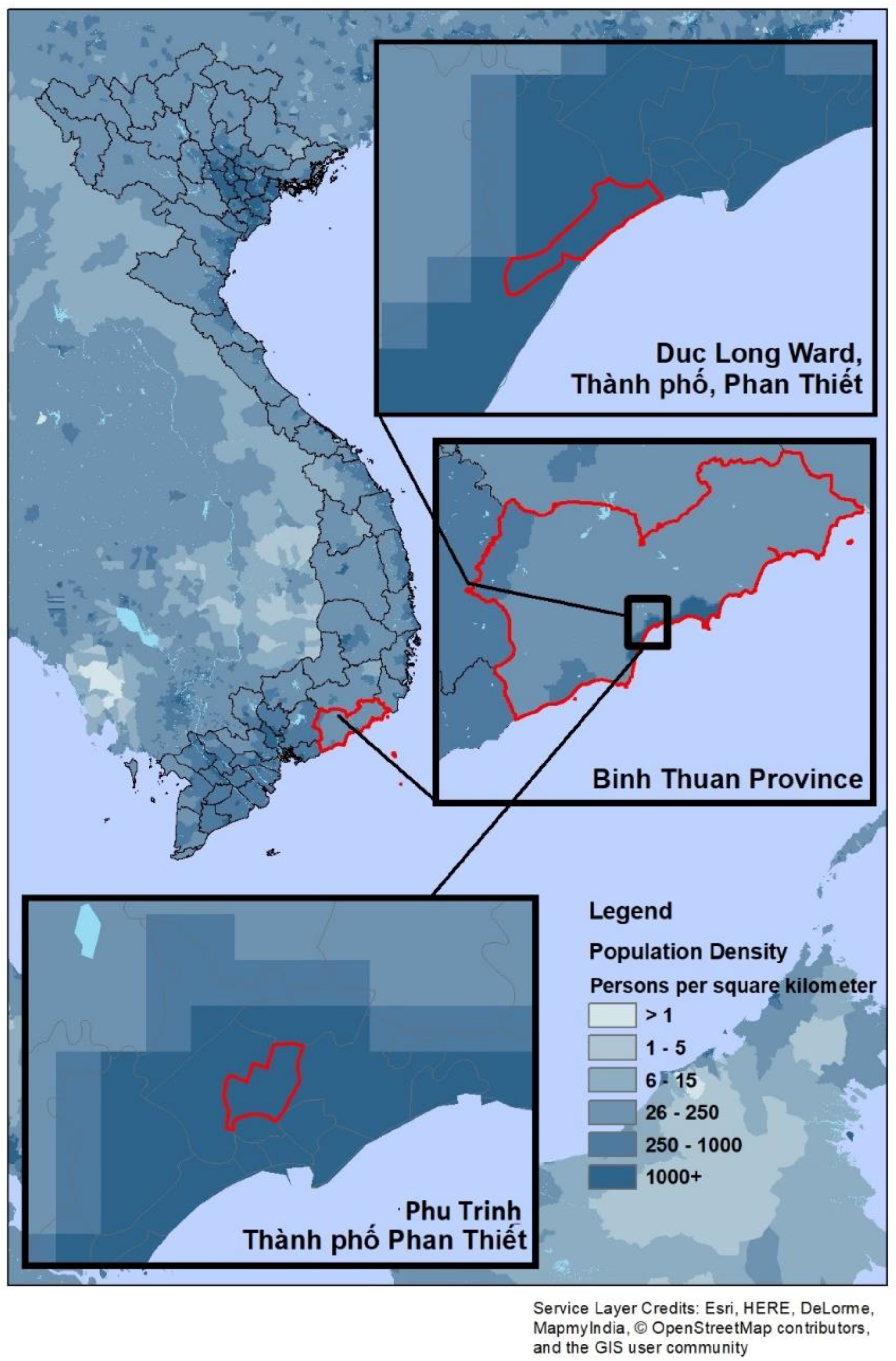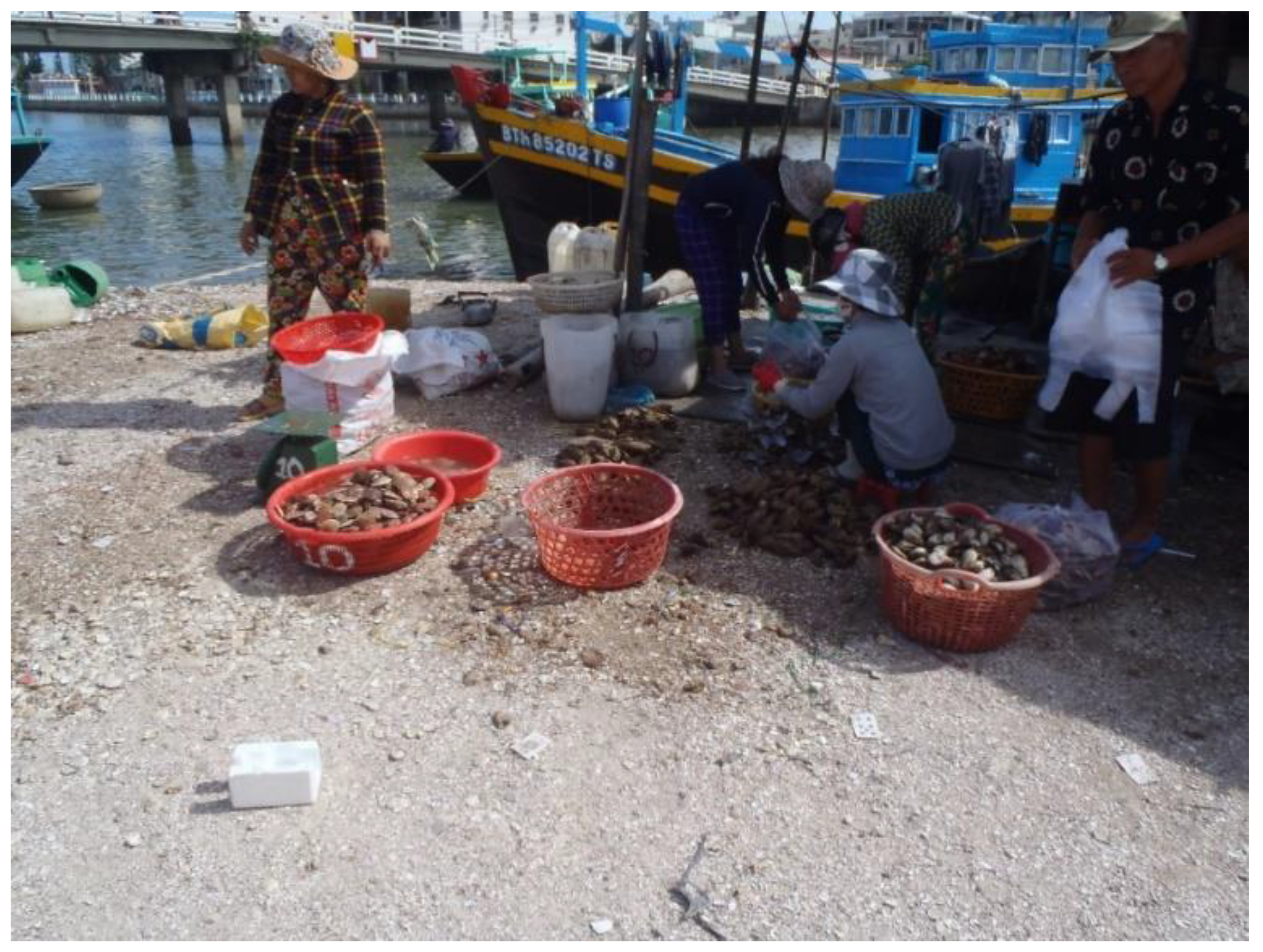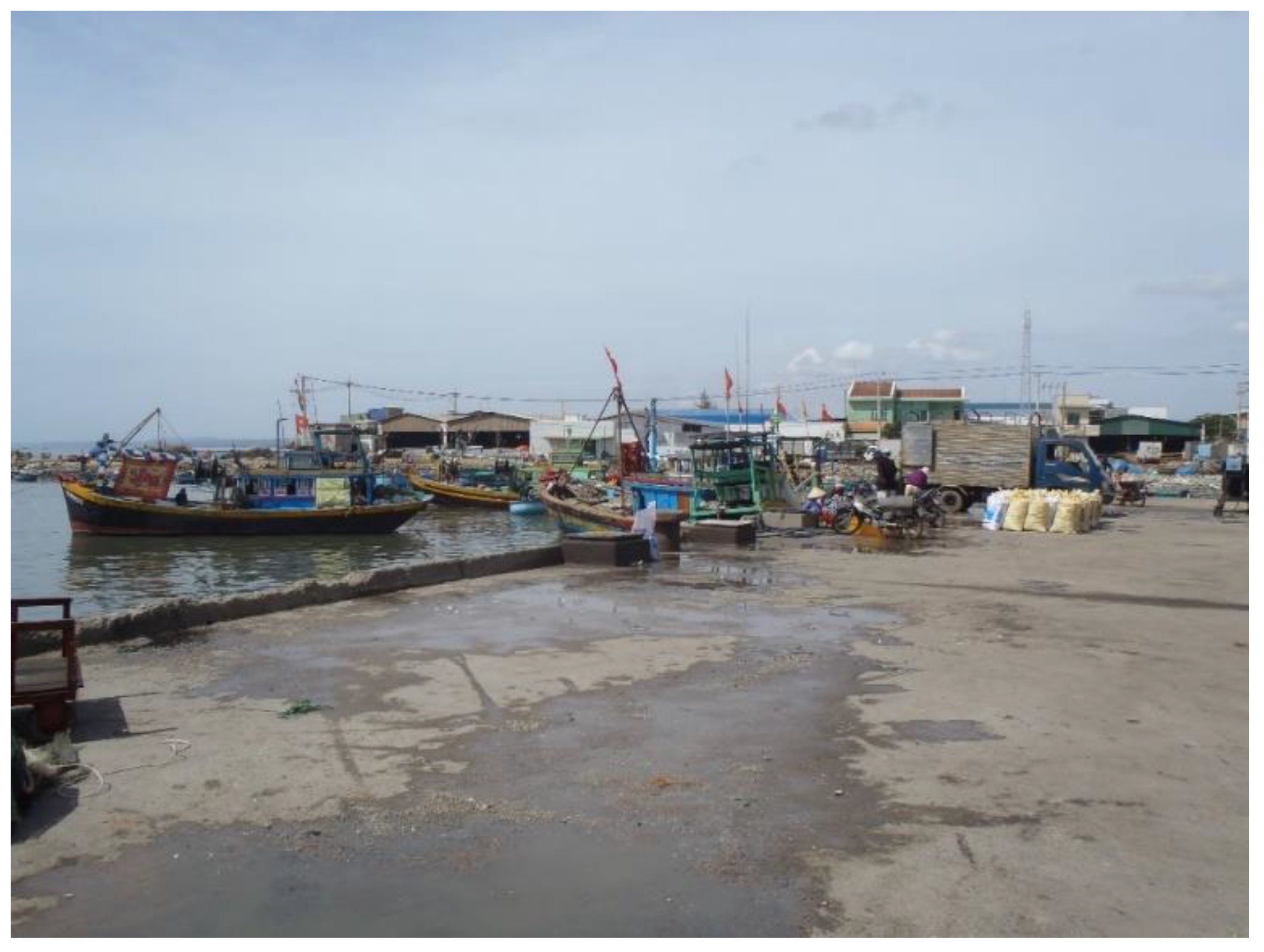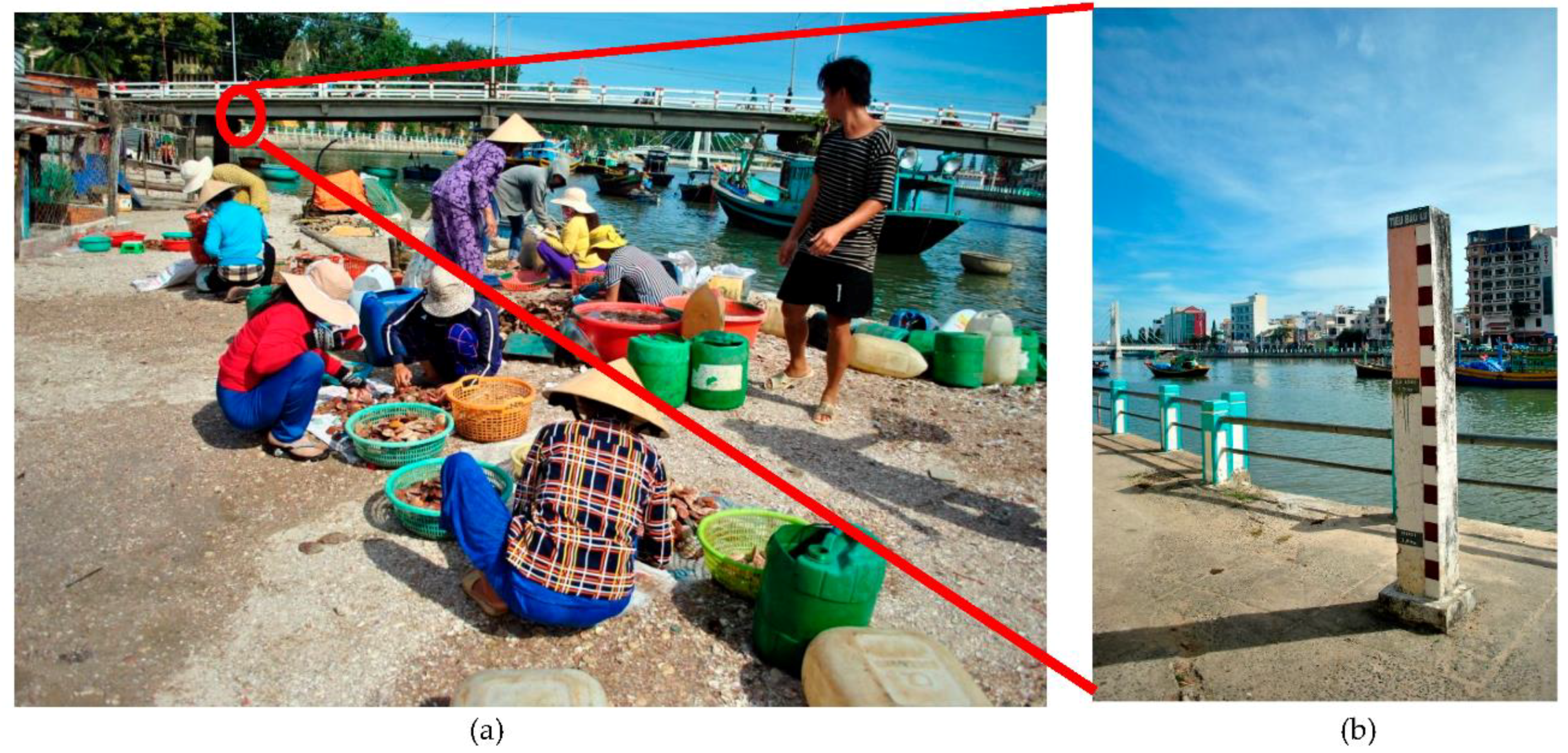Survey Tool for Rapid Assessment of Socio-Economic Vulnerability of Fishing Communities in Vietnam to Climate Change
Abstract
1. Introduction
2. Materials and Methods
2.1. Study Areas
- Phu Trinh, having one of the highest population densities in the region (Figure 1), is a small fishing community built on top of land at the side of a river bank, formed through the accumulation of mud, solid waste and discarded seashells and seafood waste (Figure 2). It is one of the lowest-lying areas in the city of Phan Thiet and thus particularly vulnerable to sea level rise, storm surges and fluvial flooding [29].
- Duc Long, is an area of the city that has been experiencing significant beach erosion. In this area, improvised beach erosion protection, such as the use of sandbags, has been practiced for some time. However, these improvised measures were not successful in stopping the erosion [10]. As with Phu Trinh, Duc Long is also one of the most densely populated areas in the province of Binh Thuan, with significant numbers of fishermen (Figure 3).
2.2. Scoring Guide
2.3. Assessing Exposure
2.4. Assessing Sensitivity
2.5. Assessing Lack of Adaptive Capacity
3. Results
3.1. Exposure of Phan Thiet to Climate Change Variables
3.2. Characteristics of Fishery Sector
3.3. Demographics and Government Support
3.4. Results of Government Meeting
3.5. Summary of Sensitivity and Lack of Adaptive Capacity Scores
3.6. Relative Vulnerability
4. Discussion
5. Conclusions
Author Contributions
Funding
Acknowledgments
Conflicts of Interest
References
- Gupta, J. Climate change and development cooperation: Trends and questions. Curr. Opin. Environ. Sustain. 2009, 1, 207–213. [Google Scholar] [CrossRef]
- Allison, E.H.; Perry, A.L.; Badjeck, M.C.; Nei Adger, W.; Brown, K.; Conway, D.; Halls, A.S.; Pilling, G.M.; Reynolds, J.D.; Andrew, N.L.; et al. Vulnerability of national economies to the impacts of climate change on fisheries. Fish Fish. 2009, 10, 173–196. [Google Scholar] [CrossRef]
- FAO. The State of World Fisheries and Aquaculture; FAO: Rome, Italy, 2009; Volume 35. [Google Scholar]
- Takagi, H.; Thao, N.D.; Esteban, M. Tropical Cyclones and Storm Surges in Southern Vietnam; Elsevier Inc.: Amsterdam, The Netherlands, 2014. [Google Scholar]
- Thang, N.T. Policy on Climate Change in Vietnam. In Proceedings of the 2nd International Conference on Sustainability Science in Asia (ICSS-Asia), Hanoi, Vietnam, 2–4 March 2011. [Google Scholar]
- Thuc, T. National Target Program to Respond to Climate Change; APAN: Hanoi, Vietnam, 2016. [Google Scholar]
- Hanh, T.; Furukawa, M. Impact of sea level rise on coastal zone of Vietnam. Bull. Coll. Sci. 2007, 84, 45–59. [Google Scholar]
- Kopp, R.E.; DeConto, R.M.; Bader, D.A.; Hay, C.C.; Horton, R.M.; Kulp, S.; Oppenheimer, M.; Pollard, D.; Strauss, B.H. Evolving Understanding of Antarctic Ice-Sheet Physics and Ambiguity in Probabilistic Sea-Level Projections. Earth’s Future 2017, 5, 1217–1233. [Google Scholar] [CrossRef]
- le Bars, D.; Drijfhout, S.; de Vries, H. A high-end sea level rise probabilitic projection including rapid Antarctic ice sheet mass loss. Environ. Res. Lett. 2017, 12, 044013. [Google Scholar] [CrossRef]
- Takagi, H.; Thao, N.D.; Esteban, M.; Mikami, T.; van Cong, L.; Ca, V.T. Handbook of Coastal Disaster Mitigation for Engineers and Planners; Elsevier: Woburn, UK, 2015; pp. 235–255. [Google Scholar]
- Knutson, T.R.; Tuleya, R.E. Impact of CO2-induced warming on simulated hurricane intensity and precipitation: Sensitivity to the choice of climate model and convective parameterization. J. Clim. 2004, 17, 3477–3495. [Google Scholar] [CrossRef]
- Nakamura, R.; Shibayama, T.; Esteban, M.; Iwamoto, T. Future Typhoon and Storm Surges Under Different Global Warming Scenarios: Case Study of Typhoon Haiyan (2013); Springer: Dordrecht, The Netherlands, 2016; Volume 8. [Google Scholar]
- Knutson, T.R.; McBride, J.L.; Chan, J.; Emanuel, K.; Holland, G.; Landsea, C.; Held, I.; Kossin, J.P.; Srivastava, A.K.; Sugi, M. Tropical Cyclones and Climate Change. Nat. Geosci. 2010, 3, 157–163. [Google Scholar] [CrossRef]
- Stromberg, P.M.; Esteban, M.; Gasparatos, A. Climate change effects on mitigation measures: The case of extreme wind events and Philippines’ biofuel plan. Environ. Sci. Policy 2011, 14, 1079–1090. [Google Scholar] [CrossRef]
- Esteban, M.; Thao, N.D.; Takagi, H.; Shibayama, T. Increase in Port Downtime and Damage in Vietnam Due to a Potential Increase in Tropical Cyclone Intensity. In Climate Change and the Sustainable Use of Water Resources; Springer: Berlin/Heidelberg, Germany, 2012. [Google Scholar]
- Imamura, F.; To, D. Flood and Typhoon Disasters in Viet Nam in the Half Century since 1950. Nat. Hazards 2017, 15, 45–59. [Google Scholar]
- Takagi, H.; Kashihara, H.; Esteban, M.; Shibayama, T. Assessment of Future Stability of Breakwaters under Climate Change. Coast. Eng. J. 2011, 53, 21–39. [Google Scholar] [CrossRef]
- Gledhill, D.; NOAA; White, M.; Salisbury, J.; Thomas, H.; Misna, I.; Liebman, M.; Mook, B.; Grear, J.; Candelmo, A.; et al. Ocean and Coastal Acidification off New England and Nova Scotia. Oceanography 2015, 25, 182–197. [Google Scholar] [CrossRef]
- Schmutter, K.; Nash, M.; Dovey, L. Ocean acidification: Assessing the vulnerability of socioeconomic systems in Small Island Developing States. Reg. Environ. Chang. 2017, 17, 973–987. [Google Scholar] [CrossRef]
- IFAD. Climate Change Analysis and Adaptation Responses; IFAD: Rome, Italy, 2012. [Google Scholar]
- Hinkel, J.; Klein, R.J.T. Integrating Knowledge for Assessing Coastal Vulnerability to Climate Change. In Manage Coastal Vulnerability Integrated Approach; Elsevier Inc.: Amsterdam, The Netherlands, 2007; pp. 1–20. [Google Scholar]
- Lins-de-Barros, F.M. Integrated coastal vulnerability assessment: A methodology for coastal cities management integrating socioeconomic, physical and environmental dimensions—Case study of Região dos Lagos, Rio de Janeiro, Brazil. Ocean Coast. Manag. 2017, 149, 1–11. [Google Scholar] [CrossRef]
- Nguyen, T.T.X.; Bonetti, J.; Rogers, K.; Woodroffe, C.D. Indicator-based assessment of climate-change impacts on coasts: A review of concepts, methodological approaches and vulnerability indices. Ocean Coast. Manag. 2016, 123, 18–43. [Google Scholar] [CrossRef]
- Licuanan, W.Y.; Samson, M.S.; Mamauag, S.S.; David, L.T.; Rosario, R.B.; Quibilan, M.C.C.; Siringan, F.P.; Maria, M.Y.Y.S.; España, N.B.; Villanoy, C.L. I-C-SEA Change: A participatory tool for rapid assessment of vulnerability of tropical coastal communities to climate change impacts. Ambio 2015, 44, 718–736. [Google Scholar] [CrossRef] [PubMed]
- WWF-South Pacific Programme. Climate Witness Community Toolkit; WWF South Pacific: Suva, Fiji, 2009. [Google Scholar]
- Maynard, J.A.; Marshall, P.A.; Johnson, J.E.; Harman, S. Building resilience into practical conservation: Identifying local management responses to global climate change in the southern Great Barrier Reef. Coral Reefs 2010, 29, 381–391. [Google Scholar] [CrossRef]
- Tompkins, E.L.; Adger, W.N. Does Adaptive Management of Natural Resources Enhance Resilience to Climate Change? Ecol. Soc. 2004, 9, 10. [Google Scholar] [CrossRef]
- Knaepen, H.L. 17 Mainstreaming Climate Change Adaptation into Vietnamese Development as a New Policy Arrangement; Elsevier Inc.: Amsterdam, The Netherlands, 2014. [Google Scholar]
- Esteban, M.; Takagi, H.; Valenzuela, V.P.; Thao, N.D.; Tam, T.T.; Trang, D.D.T.; Anh, L.T. Awareness of Coastal Disasters: Case of an Impoverished Low-Lying River Mouth Community in Southern Vietnam. Int. J. Sustain. Future Hum. Secur. 2017, 5, 77–85. [Google Scholar] [CrossRef]
- IPCC. Annex II: Glossary. In Climate Change 2014: Synthesis Report. Contribution of Working Groups I, II and III to the Fifth Assessment Report of the Intergovernmental Panel on Climate Change; Mach, K.J., Planton, S., von Stechow, C., Eds.; IPCC: Geneva, Switzerland, 2014; pp. 117–130. [Google Scholar]
- Adger, W.N. Social and ecological resilience: Are they related? Prog. Hum. Geogr. 2000, 24, 347–364. [Google Scholar] [CrossRef]
- MoNRE. Climate Change, Sea Level Rise Scenarios for Viet Nam: Summary for Policymakers; MoNRE: Hanoi, Vietnam, 2016; p. 37.
- Esteban, M.; Takagi, H.; Shibayama, T. Handbook of Coastal Disaster Mitigation for Engineers and Planners; Butterworth-Heinemann (Elsevier): Oxford, UK, 2015. [Google Scholar]
- Jamero, M.L.; Onuki, M.; Esteban, M.; Tan, N. Community-based adaptation in low-lying islands in the Philippines: Challenges and lessons learned. Reg. Environ. Chang. 2018, 18, 2249–2260. [Google Scholar] [CrossRef]
- Takagi, H.; Fujii, D.; Esteban, M.; Yi, X. Effectiveness and Limitation of Coastal Dykes in Jakarta: The Need for Prioritising Actions against Land Subsidence. Sustainability 2017, 9, 619. [Google Scholar] [CrossRef]
- Takagi, H.; Esteban, M.; Tam, T.T. Coastal Vulnerabilities in a Fast-Growing Vietnamese City; Elsevier Inc.: Amsterdam, The Netherlands, 2014. [Google Scholar]
- Ding, Q.; Chen, X.; Hilborn, R.; Chen, Y. Vulnerability to impacts of climate change on marine fisheries and food security. Mar. Policy 2017, 83, 55–61. [Google Scholar] [CrossRef]
- MARD; FAO. Vietnam Country Programming Framework 2012–2016; MARD; FAO: Hanoi, Vietnam, 2013; p. 55. [Google Scholar]
- Muallil, R.N.; Geronimo, R.C.; Cleland, D.; Cabral, R.B.; Doctor, M.V.; Cruz-Trinidad, A.; Aliño, P.M. Willingness to exit the artisanal fishery as a response to scenarios of declining catch or increasing monetary incentives. Fish. Res. 2011, 111, 74–81. [Google Scholar]
- Salik, K.M.; Jahangir, S.; Zahdi, W.Z.; Hasson, S. Climate change vulnerability and adaptation options for the coastal communities of Pakistan. Ocean Coast. Manag. 2015, 112, 61–73. [Google Scholar] [CrossRef]
- CRED. EM-DAT: The International Disaster Database. 2018. Available online: www.emdat.be/database (accessed on 11 September 2018).
- Chambers, R. Vulnerability, coping and policy (editorial introduction). IDS Bull. 2006, 37, 33–40. [Google Scholar] [CrossRef]
- Yoo, G.; Hwang, J.H.; Choi, C. Development and application of a methodology for vulnerability assessment of climate change in coastal cities. Ocean Coast. Manag. 2011, 54, 524–534. [Google Scholar] [CrossRef]
- Smit, B.; Wandel, J. Adaptation, adaptive capacity and vulnerability. Glob. Environ. Chang. 2006, 16, 282–292. [Google Scholar] [CrossRef]
- Bulla, B.R.; Craig, E.A.; Steelman, T.A. Climate change and adaptive decision making: Responses from North Carolina coastal officials. Ocean Coast. Manag. 2017, 135, 25–33. [Google Scholar] [CrossRef]




| Climate Change Variable | Range given for the RCP 4.5 Climate Scenario | Exposure Score Thresholds |
|---|---|---|
| Change in annual temperature | 0.6 to 0.8 °C | Low 0.6–0.69 °C Moderate 0.7–0.79 °C High >0.8 °C |
| Change in annual Rainfall | 1.8 to 24.4% | Low 1.8–9.2% Moderate 9.3–16.9% High 17.0–24.4% |
| Sea level rise | 12 to 14 cm | Low land elevation (0.0–0.49 m) Moderate 0.5–1.99 m High land elevation >1.99 m |
| Elevation | Elevation level | Change in Annual Rainfall | ||
| High | Moderate | Low | ||
| Low | High | High | Moderate | |
| Moderate | High | Moderate | Moderate | |
| High | Low | Low | Low | |
| Criteria | Low | Moderate | High | ||
|---|---|---|---|---|---|
| 1 Point | 2 Points | 3 Points | 4 Points | 5 Points | |
| Type of fish | 100% pelagic fishes | 75% pelagic and 25% demersal fishes | 50% pelagic and 50% demersal fishes | 25% pelagic and 75% demersal fishes | 100% demersal fishes |
| Average Catch Rate | >8 kg per day | 6–8 kg per day | 4–6 kg per day | 2–4 kg per day | <2 kg per day |
| Fishing Gears | 100% mobile fishing gears | 75% mobile and 25% habitat-associated | 50% mobile and 50% habitat-associated | 25% mobile and 75% habitat-associated gears | 100% Habitat-associated gear |
| Dependence on Fishery as Nutrition | Once a week | Twice a week | 3–4 times a week | 5–6 times a week | Everyday |
| Dependence to Fishing | 30% or less of the population are fishers | 31–40% of the population are fishers | 41–50% of the population are fishers | 50–60% of the population are fishers | More than 60% of the population are fishers |
| Criteria | Low | Moderate | High | ||
|---|---|---|---|---|---|
| 1 Point | 2 Points | 3 Points | 4 Points | 5 Points | |
| Population Density | <100 persons/sq km2 | 100–200 persons/sq km2 | Between 201 and 350 persons/sq km2 | Between 351 and 500 persons/sq km2 | More than 500 persons/sq km2 |
| Change in Land | Heavily accreting | Moderately accreting | Stable | Moderately eroding | Heavily eroding |
| Proneness to erosion | 100% Rocky shore | 75% rocky 25% gravel shore | 50% rocky and 50% gravel shore | 25% gravel and 75% sandy shore | 100% sandy shore |
| Width of the Shore | >100 m | 90–100 m | 70–89 m | 50–69 m | <50 m |
| Criteria | Low | Moderate | High | |
|---|---|---|---|---|
| 2 Point | 3 Points | 4 Points | 5 Points | |
| Fishing Experience | <5 Years | Between 5 and 10 years | Between 10 and 20 years | >20 Years |
| Additional Income Source | +3 Livelihood Source | +2 Livelihood Source | +1 Livelihood Source | Fishing as sole livelihood source |
| Fisheries Management Engagement | More than 60% of the population engaged | Between 40% and 60% | Between 20% and 40% | Less than 20% |
| Education | Less than 20% of the population has less than 10 years of schooling | Between 20% and 40% | Between 40% and 60% | More than 60% |
| Criteria | Low | Moderate | High | |
|---|---|---|---|---|
| 2 Point | 3 Points | 4 Points | 5 Points | |
| Solid Waste Accumulation | No | Solid Waste accumulates for 0–4 months every year | Solid Waste accumulates for 5–11 months every year | Solid Waste accumulates all year round |
| Land Use | Industrial | Commercial | Residential | Rural, fishing, agricultural |
| Local Climate Change Adaptation (CCA) Policy | Comprehensive CCA Policy with enforcement means | Comprehensive CCA Policy without enforcement means | Official commitment to create a local policy | Non-existent |
| Climate Data | Extensive scenario research: public access to general data: (all-scenarios approach) | Single scenario research: public access to general data | Basic scenario research | Non-existent |
| CCA Funding | Clear-cut separate CC budget | No separate CC budget: more than 50% funded by recipient country on CC projects | No separate CC budget: more than 90% funded by recipient country on CC projects | Non-existent |
| Climate Change Variable | ||||||
|---|---|---|---|---|---|---|
| Change in Annual Temperature (2016–2035) | Assessment | Change in Annual Rainfall Relative to Land Elevation | Assessment | Sea Level Rise Exposure Based on Land Elevation | Assessment | |
| Phu Trinh | 0.7 °C | MODERATE | 14.1%, Low Elevation | HIGH | >0.49 cm | HIGH |
| Duc Long | 0.7 °C | MODERATE | 14.1%, Moderate Elevation | MODERATE | 0.5–1.99m | MODERATE |
| Phu Trinh | Duc Long | |
|---|---|---|
| Sex | Male:55% | Male:73% |
| Female:45% | Female:27% | |
| Highest Educational Attainment | No Formal Schooling: 46% | No Formal Schooling: 45% |
| Primary School: 28% | Primary School: 38% | |
| High school Graduate: 18% | High school Graduate: 18% | |
| College Graduate: 17% | College Graduate: 0% |
| Sensitivity | ||||
|---|---|---|---|---|
| Criteria | Phu Trinh | Point | Duc Long | Point |
| Type of Fish | Shells | 5 | Pelagic Fish (e.g., Tuna, Sardines, Mackerel) | 1 |
| Average Catch Rate | More than 8 kg a day | 1 | More than 8 kg a day | 1 |
| Fishing Gears | Both types present | 3 | Mostly mobile fishing gears | 1 |
| Dependence of Fishery as Nutrition | Everyday | 5 | Everyday | 5 |
| Dependence to Fishing | More than 60% are fishermen | 5 | More than 60% are fishermen | 5 |
| Population Density | 13,333/sq.km. | 5 | 8371/sq.km. | 5 |
| Change in Land | Moderately Accreting | 2 | Heavily Eroding | 5 |
| Proneness to erosion | Gravel and Sand | 4 | Sandy | 5 |
| Width of the Shore | <50 m | 5 | >100m | 1 |
| AVERAGE | 3.9 | 3.2 | ||
| SENSITIVITY LEVEL | MODERATE | MODERATE | ||
| Lack of Adaptive Capacity Criteria | ||||
|---|---|---|---|---|
| Criteria | Phu Trinh | Points | Duc Long | Points |
| Fishing Experience | More than 20 years | 5 | Between 10–20 years | 4 |
| Additional Income Source | None | 5 | None | 5 |
| Fisheries Engagement | 38% | 4 | 15% | 5 |
| Education | 74% | 5 | 83% | 5 |
| Solid Waste Accumulation | All year round | 5 | All year round | 5 |
| Land Use | Residential | 4 | Commercial | 3 |
| Local CCA Policy | Non-existent | 5 | Non-existent | 5 |
| Climate Data | Basic Scenario | 4 | Basic Scenario | 4 |
| CCA Funding | No separate CC budget | 4 | No separate CC budget | 4 |
| AVERAGE | 4.6 | 4.4 | ||
| LACK OF ADAPTIVE CAPACITY LEVEL | HIGH | HIGH | ||
| Phu Trinh | Duc Long | ||||||
|---|---|---|---|---|---|---|---|
| Vulnerability | Exposure | Sensitivity | Lack of Adaptive Capacity | Vulnerability | Exposure | Sensitivity | Lack of Adaptive Capacity |
| Temperature | |||||||
| High | Moderate | Moderate | High | High | Moderate | Moderate | High |
| Rainfall | |||||||
| High | High | Moderate | High | High | Moderate | Moderate | High |
| Sea Level Rise relative to Land Elevation | |||||||
| High | High | Moderate | High | High | Moderate | Moderate | High |
© 2018 by the authors. Licensee MDPI, Basel, Switzerland. This article is an open access article distributed under the terms and conditions of the Creative Commons Attribution (CC BY) license (http://creativecommons.org/licenses/by/4.0/).
Share and Cite
Avelino, J.E.; Crichton, R.N.; Valenzuela, V.P.; Odara, M.G.N.; Padilla, M.A.T.; Kiet, N.; Anh, D.H.; Van, P.C.; Bao, H.D.; Thao, N.H.P.; et al. Survey Tool for Rapid Assessment of Socio-Economic Vulnerability of Fishing Communities in Vietnam to Climate Change. Geosciences 2018, 8, 452. https://doi.org/10.3390/geosciences8120452
Avelino JE, Crichton RN, Valenzuela VP, Odara MGN, Padilla MAT, Kiet N, Anh DH, Van PC, Bao HD, Thao NHP, et al. Survey Tool for Rapid Assessment of Socio-Economic Vulnerability of Fishing Communities in Vietnam to Climate Change. Geosciences. 2018; 8(12):452. https://doi.org/10.3390/geosciences8120452
Chicago/Turabian StyleAvelino, John Erick, Richard Nathan Crichton, Ven Paolo Valenzuela, Merenchi Galappaththige Nipuni Odara, Michael Adrian Triguero Padilla, Nguyen Kiet, Dang Hoang Anh, Pham Cam Van, Ho Dac Bao, Nguyen Hoang Phuong Thao, and et al. 2018. "Survey Tool for Rapid Assessment of Socio-Economic Vulnerability of Fishing Communities in Vietnam to Climate Change" Geosciences 8, no. 12: 452. https://doi.org/10.3390/geosciences8120452
APA StyleAvelino, J. E., Crichton, R. N., Valenzuela, V. P., Odara, M. G. N., Padilla, M. A. T., Kiet, N., Anh, D. H., Van, P. C., Bao, H. D., Thao, N. H. P., Linh, M. T. Y., Hoai, P. T. P., Thao, N. D., Onuki, M., & Esteban, M. (2018). Survey Tool for Rapid Assessment of Socio-Economic Vulnerability of Fishing Communities in Vietnam to Climate Change. Geosciences, 8(12), 452. https://doi.org/10.3390/geosciences8120452





